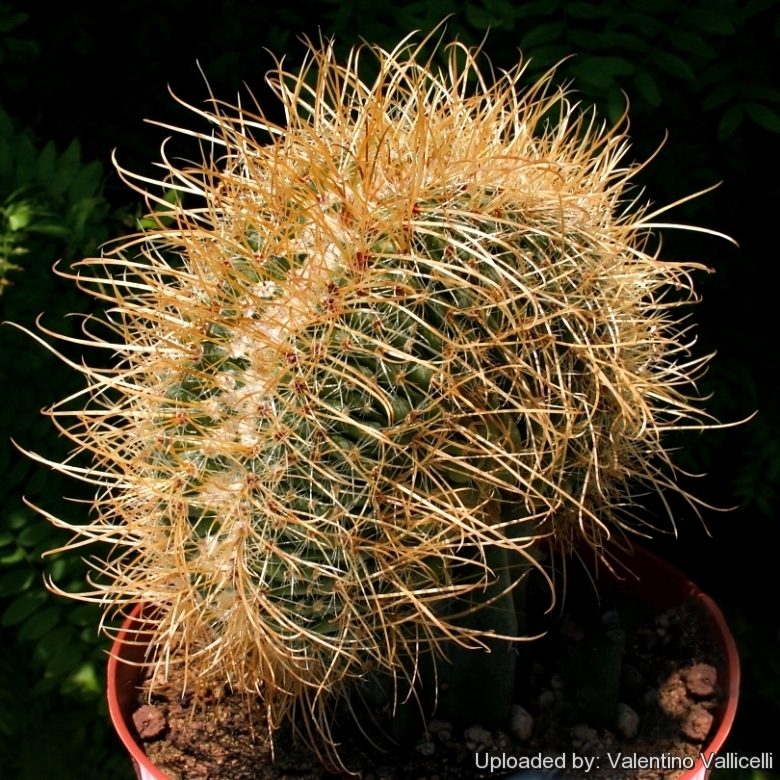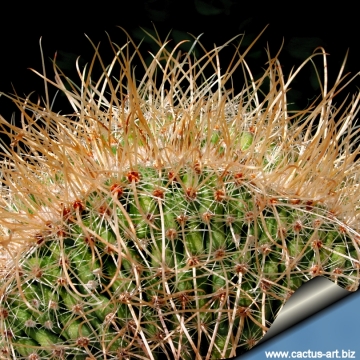Accepted Scientific Name: Parodia maassii (Heese) A.Berger
Kakteen (Berger) 344. 1929 (Often mispelled: maassi, masii, masi, massii or massi) (A.Berger)

Parodia maassii f. cristata Photo by: Valentino Vallicelli
Origin and Habitat: Garden origin (Nursery produced cultivar)
Synonyms:
See all synonyms of Parodia maassii
back
Accepted name in llifle Database:Parodia maassii (Heese) A.BergerKakteen (Berger) 344. 1929 (Often mispelled: maassi, masii, masi, massii or massi)Synonymy: 30
back
Description: The typical Parodia maassiiSN|5784]]SN|5784]] is a spherical cactus covered with long, curved, dense, and variably coloured spines. In particular the central spines are strong (measuring between 3 and 7 cm). They are yellow on the upper part of the plant, and go upwards. In older parts they become clear yellow, and go downwards. The crested form is very rare, and particularly sought after for its armament of long hooked spines. Also this crest gets quite large, making a spectacular specimen.
Stem: Mid-green to intense green color, up to15 cm. wide, with the apical part densely covered with white wool.
Ribs: 13- 21, chinned and arranged in spiral.
Areoles: Big and woolly at first, but they become naked with age.
Flowers: Funnel-shaped, large coppery-yellow or orange, but they can also be carmine or red with an orange center. 3 (or more) cm across.
Subspecies, varieties, forms and cultivars of plants belonging to the Parodia maassii group
 Parodia maassii (Heese) A.Berger: has globular stems with long hooked spines and yellow to red flowers. It is extremely variable. Distribution: Southern Bolivia and Northern Argentina.
Parodia maassii (Heese) A.Berger: has globular stems with long hooked spines and yellow to red flowers. It is extremely variable. Distribution: Southern Bolivia and Northern Argentina. Parodia maassii f. cristata hort.: The crested form is very rare, and particularly sought after for its armament of long hooked spines. There are several clones with variable spination.
Parodia maassii f. cristata hort.: The crested form is very rare, and particularly sought after for its armament of long hooked spines. There are several clones with variable spination.- Parodia maxima F.Ritter: has larger stems, longer creamy-yellow hooked central spines (up to 7 cm long) and yellow flowers. Distribution: Cieneguillas, Paicho Valley, and adjacent areas, Tarija, Bolivia
 Parodia maxima f. cristata hort.: it is a robust crested form with long creamy-yellow hooked central spines.
Parodia maxima f. cristata hort.: it is a robust crested form with long creamy-yellow hooked central spines. Parodia suprema F.Ritter: has longer brown hooked central spines (up to 7 cm long) and red flowers. Distribution: Paichu-valley, Sama Pass to Iscayachi, Tarija, Bolivia.
Parodia suprema F.Ritter: has longer brown hooked central spines (up to 7 cm long) and red flowers. Distribution: Paichu-valley, Sama Pass to Iscayachi, Tarija, Bolivia.
Bibliography: Major references and further lectures
1) James Cullen, Sabina G. Knees, H. Suzanne Cubey “The European Garden Flora Flowering Plants: A Manual for the Identification of Plants Cultivated in Europe, Both Out-of-Doors and Under Glass” Cambridge University Press, 11/Aug./2011
2) David Hunt, Nigel Taylor “The New Cactus Lexicon” DH Books, 2006
3) Edward F. Anderson “The Cactus Family” Timber Press, 2001
 Parodia maassii f. cristata Photo by: Cactus Art
Parodia maassii f. cristata Photo by: Cactus Art Parodia maassii f. cristata Photo by: Cactus Art
Parodia maassii f. cristata Photo by: Cactus ArtCultivation and Propagation: It is not too difficult in a greenhouse, although grows quite slowly. It is usually seen as a grafted plant but can grow on its own roots too.
Soil: Use a mineral well permeable soil with little organic matter (peat, humus).
Exposure: They need a good amount of light shade to full sun this help to keep the plants healthy, although slow growth.
Watering: Water sparingly from March till October (weekly during summertime, if the weather is sunny enough), with a little fertilizer added. Less or no water during cold winter months, or when night temperatures remain below 10° to prevent root loss. It is sensitive to overwatering (rot prone).
Fertilization: Feeding may not be necessary at all if the compost is fresh then, feed in summer only if the plant hasn't been repotted recently. Do not feed the plants from September onwards as this can cause lush growth which can be fatal during the darker cold months.
Hardiness: Keep perfectly dry in winter at temperatures from 5 to 15 degrees centigrade. (but it is relatively cold resistant and hardy to -5° C, or possibly colder for short periods) In the rest period no high atmospheric humidity!! (Temperature Zone: USDA 9-11)
Crested growth: Unlike 'monstrose' varieties of plants, where the variation from normal growth is due to genetic mutation, crested growth can occur on normal plants. Sometimes it's due to variances in light intensity, or damage, but generally the causes are unknown. A crested plant may have some areas growing normally, and a cresting plant that looks like a brain, may revert to normal growth for no apparent reason. If you have any of the crested part left you need to remove the normal growth and leave the crested part behind this will need to be done regularly.
Propagation: Grafting or cuttings. Plants are usually grafted onto column-shaped cacti but proved to be able to produce their own roots if degrafted. Cuttings will take root in a minimum temperature of 20° C (but better in hot weather). Cuttings of healthy shoots can be taken in the spring and summer. Cut the stem with a sharp, sterile knife, leave the cutting in a warm, dry place for a week or weeks (depending on how thick the cutting is) until a callus forms over the wound. Once the callus forms, the cutting may be inserted in a container filled with firmed cactus potting mix topped with a surface layer of coarse grit. They should be placed in the coarse grit only; this prevents the cut end from becoming too wet and allows the roots to penetrate the rich compost underneath. The cuttings should root in 2 to 6 weeks. Large crested piece must be placed on the soil surface without burying the plant base down in the soil.












